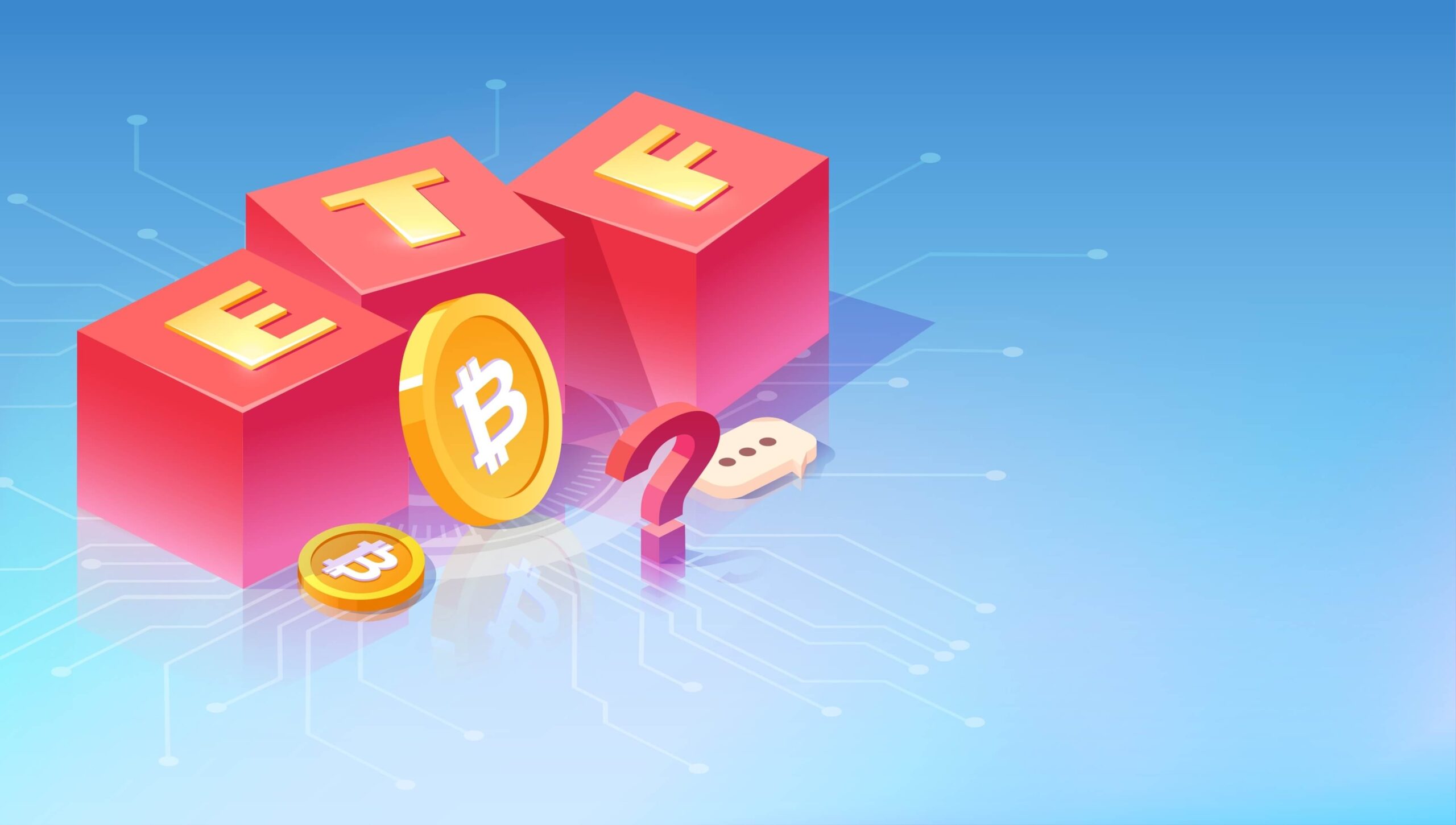The Bitcoin ETF Buzz of 2024, Explained
It's official, Bitcoin ETFs have finally been approved by the SEC. Take a closer look and learn what this means for the investment landscape and beyond.


The buzz surrounding the Bitcoin ETF has captured the attention of many, with promises of transforming the Bitcoin market through a new alternative investment. But what exactly is a Bitcoin ETF, and why is it such a big deal?
In this beginner’s guide, we want to get you up to speed with the concept of Bitcoin ETF to help you follow along with the latest news.
What is an ETF?
ETF stands for Exchange Traded Fund. If you’ve dabbled in buying stocks through a brokerage platform, you may have encountered this term.
The key advantage of investing in an ETF lies in the opportunity to gain exposure to a diversified portfolio of high-value stocks without the need to buy each stock individually.
In traditional stock markets, acquiring shares of influential companies individually can become prohibitively expensive.

However, with an ETF, this process becomes more accessible. Imagine buying one lot of shares that collectively represents ownership in 50 different companies.
For instance, the S&P/NZX 50 ETF mirrors this concept by tracking the list of the 50 most significant companies in New Zealand based on market capitalization.
In essence, an ETF simplifies investment by offering exposure to a diverse range of stocks, and this principle extends to the Bitcoin ETF as well.
What about the Bitcoin ETF?
The concept of a Bitcoin ETF, while not identical to a traditional ETF for publicly listed company shares, operates on a similar principle.
Essentially, a Bitcoin ETF’s underlying asset is only Bitcoin, allowing investors to indirectly engage with the original crypto asset.
Here’s a breakdown of how it works:
An issuer acquires Bitcoins and then issues ETF shares representing each unit of it. When the issuer successfully balances the supply and demand between the underlying Bitcoin and ETF shares, the ETF can closely mirror the price movements of Bitcoin.
While holding a Bitcoin ETF doesn’t equate to owning actual Bitcoin, it’s made clear that investors of Bitcoin ETFs own shares of the issuer’s Bitcoin holdings.

Bitcoin ETFs also offer an advantage by eliminating the need for investors to handle custody and secure wallets. This feature proves attractive to companies and large investors who wish to avoid the risk associated with potential losses due to misplaced or stolen private keys.
Now, you might wonder. Shouldn’t Bitcoin ETFs have already existed, considering the concept of ETFs has been around since the ’90s, and that Bitcoin itself is 15 years old?
Well, Bitcoin ETFs have been present in various countries for quite some time. Brazil, Chile, and Canada have witnessed investors exploring cryptocurrency ETFs, with Canada notably offering a more crypto-friendly market.
In Canada, ETFs provide straightforward access to major digital currencies and diverse options for Ethereum and combined crypto exposure.
Brazil currently hosts 13 crypto ETFs with over $285 million in assets under management, while Chile welcomed its first Bitcoin ETF in March 2021. So, why the recent buzz about Bitcoin ETFs?
The United States Securities and Exchange Commission (SEC) recently approved the first Bitcoin ETF in the country.
This development is significant because, while cryptocurrency is accessible globally, U.S. crypto traders and investors contribute a substantial 24.4% to the total crypto market.
With the SEC’s approval, industry observers anticipate the influx of billions, and potentially trillions, of dollars into the Bitcoin blockchain from the United States.
New to Bitcoin? Learn about Bitcoin with our guide.
But there is already a “Futures Bitcoin ETF”…?
It’s understandable if there’s a bit of confusion regarding the approval of a Bitcoin ETF, especially considering that the SEC has approved a “futures Bitcoin ETF” in October 2021. Despite both being part of the cryptocurrency landscape, they differ significantly.
The futures Bitcoin ETF, operational in the United States for the past two years, is distinct in that it tracks the price of Bitcoin futures contracts rather than the actual price of Bitcoin itself. While the prices of Bitcoin futures can closely align with those of real Bitcoin, they aren’t a direct representation.

For some investors, the distinction doesn’t matter much, as long as their investment remains secure and profitable when actual Bitcoin investors see gains. Also, advocates for a Bitcoin futures ETF argue that such a product would offer a more regulated alternative avenue for individuals keen on Bitcoin.
SEC Chair Gary Gensler, at the time of approval for the futures Bitcoin ETF, even suggested that futures-based products might provide more robust investor protections (compared to investing in actual Bitcoin) due to the regulatory framework governing them.
But the value proposition for a futures contract-based ETF proved to be not as attractive as that of a “real” Bitcoin ETF, commonly known as a “spot Bitcoin ETF“. Here are probably reasons why:
There is a “hidden cost” to futures contract-based Bitcoin ETF
There’s a subtle but significant “hidden cost” associated with futures contract-based Bitcoin ETFs. Futures contracts are complicated. It is a time-limited agreement allowing the purchase or sale of an underlying asset at a future date.
As these contracts near expiration, they necessitate settlement or replacement with new contracts. Often, the selling prices of expiring contracts fall below the purchase prices of those expiring further into the future, a situation termed contango.
Traders, in this scenario, bear a slight loss, colloquially known as “paying a roll premium”.
Unclear Bitcoin custodial and ownership structure
Another noteworthy concern lies in the unclear custodial and ownership structure associated with Bitcoin futures contracts.
Being a derivative investment instrument, a futures contract is essentially a promise with no intrinsic ownership of Bitcoin.
Although holding a futures contract implies eventual ownership (or at least the condition of “almost owning Bitcoin” if sold at contract expiry), the derived Bitcoin assets are not necessarily secured at one location or custodial.
They could be stored or transferred across different wallets. They could still be bought or sold on a separate market. The ambiguous custodial and ownership rules arise from the fact that futures contract traders primarily focus on the contracts themselves.
Essentially, a futures contract-based Bitcoin ETF operates as a derivative of a derivative product, creating a somewhat shaky foundation for long-term investment.
The fund that sort of created a “Bitcoin ETF” ahead of time
Grayscale, a prominent crypto asset management firm, was ahead of its time by creating something that works almost similarly to a Bitcoin ETF. Launched in 2013, the Grayscale Bitcoin Trust offers shares of its portfolio, with a ticker GBTC.
In this setup, Grayscale holds actual Bitcoin, and investors who hold GBTC are indirectly investing in Bitcoin that are under Grayscale’s custody. While this might sound quite similar to a spot Bitcoin ETF in principle, it doesn’t carry the same legal designation.
GBTC indeed tracks the real price of Bitcoin, but its valuation isn’t strictly tied to it. Instead, the price of GBTC hinges on the supply and demand dynamics for its shares.

In fact, GBTC shares are sold on its own market that operates independently of Bitcoin, with shareholders having the flexibility to quote their own prices based on their sentiments towards the asset.
Shareholders can influence the GBTC price by, for example, bidding higher than Bitcoin’s current market value, resulting in a GBTC premium. Conversely, a surge in investors wanting to urgently sell GBTC shares can lower its prices, leading to a GBTC discount.
Striking a balance between buying Bitcoin to meet demand and selling them to prevent oversupply is crucial for Grayscale, and this extends to spot Bitcoin ETF issuers.
Such market mechanics can also impact spot Bitcoin ETFs. Consequently, a poorly managed ETF fund could cause a significant slide for the ETF issued by that specific issuer, resulting in a substantial discount.
It’s worth noting that GBTC faced a discount of up to 30% in January 2022, but this wasn’t necessarily due to mismanagement.
During that period, Bitcoin encountered a fast decline in price, signalling the onset of a bear market. The heightened selling pressure proved challenging for Grayscale, and perhaps any fund manager, causing the discount to widen.
However, given Grayscale’s prominent position in the crypto asset management sector, the discount eventually narrowed, offering additional rewards for GBTC discount buyers.
Key takeaways
In the next few articles, we’ll take a look at the possible impacts of the Bitcoin ETF approval news to the broader crypto market, but for now, here’s what you need to know:
The concept of a Bitcoin ETF is an exciting development in the world of cryptocurrency investments. While similar to traditional ETFs in terms of providing exposure to a diversified portfolio, a Bitcoin ETF allows investors to indirectly engage with the cryptocurrency.
The recent approval of a Bitcoin ETF by the SEC in the United States is significant, as it is expected to attract billions, if not trillions, of dollars into the Bitcoin market.
Additionally, many ETF issuers can learn from the experiences of Grayscale, whose GBTC assets offer a similar investment opportunity for investors, but with different risk factors when compared with investing in actual Bitcoins.
Overall, the introduction of Bitcoin ETFs provides a regulated and accessible avenue for individuals interested in Bitcoin, potentially impacting the market value of the cryptocurrency.
Further reading: Explore topics on all things crypto.
Share to
Stay curious and informed
Your info will be handled according to our Privacy Policy.
Make sure to follow our Twitter, Instagram, and YouTube channel to stay up-to-date with Easy Crypto!
Also, don’t forget to subscribe to our monthly newsletter to have the latest crypto insights, news, and updates delivered to our inbox.
Disclaimer: Information is current as at the date of publication. This is general information only and is not intended to be advice. Crypto is volatile, carries risk and the value can go up and down. Past performance is not an indicator of future returns. Please do your own research.
Last updated January 12, 2024





